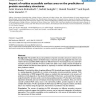BMCBI
2008
14 years 6 days ago
2008
Background: The problem of accurate prediction of protein secondary structure continues to be one of the challenging problems in Bioinformatics. It has been previously suggested t...
BMCBI
2008
14 years 6 days ago
2008
Background: Prediction of disulfide bridges from protein sequences is useful for characterizing structural and functional properties of proteins. Several methods based on differen...
BMCBI
2008
14 years 6 days ago
2008
Background: DNA microarray technology has emerged as a major tool for exploring cancer biology and solving clinical issues. Predicting a patient's response to chemotherapy is...
BMCBI
2008
14 years 6 days ago
2008
Background: Modelling proteins with multiple domains is one of the central challenges in Structural Biology. Although homology modelling has successfully been applied for predicti...
BMCBI
2007
14 years 6 days ago
2007
Background: Joint alignment and secondary structure prediction of two RNA sequences can significantly improve the accuracy of the structural predictions. Methods addressing this p...
BMCBI
2008
14 years 6 days ago
2008
Background: Leishmania and other members of the Trypanosomatidae family diverged early on in eukaryotic evolution and consequently display unique cellular properties. Their appare...
BMCBI
2007
14 years 6 days ago
2007
Background: Predicting protein residue-residue contacts is an important 2D prediction task. It is useful for ab initio structure prediction and understanding protein folding. In s...
BMCBI
2010
14 years 6 days ago
2010
Background: Our current understanding of transcription factor binding sites (TFBSs) in sequenced prokaryotic genomes is very limited due to the lack of an accurate and efficient c...
BMCBI
2010
14 years 6 days ago
2010
Background: MicroRNAs (miRNAs) are single-stranded non-coding RNAs known to regulate a wide range of cellular processes by silencing the gene expression at the protein and/or mRNA...
BMCBI
2010
14 years 6 days ago
2010
Background: Many structural properties such as solvent accessibility, dihedral angles and helix-helix contacts can be assigned to each residue in a membrane protein. Independent s...


